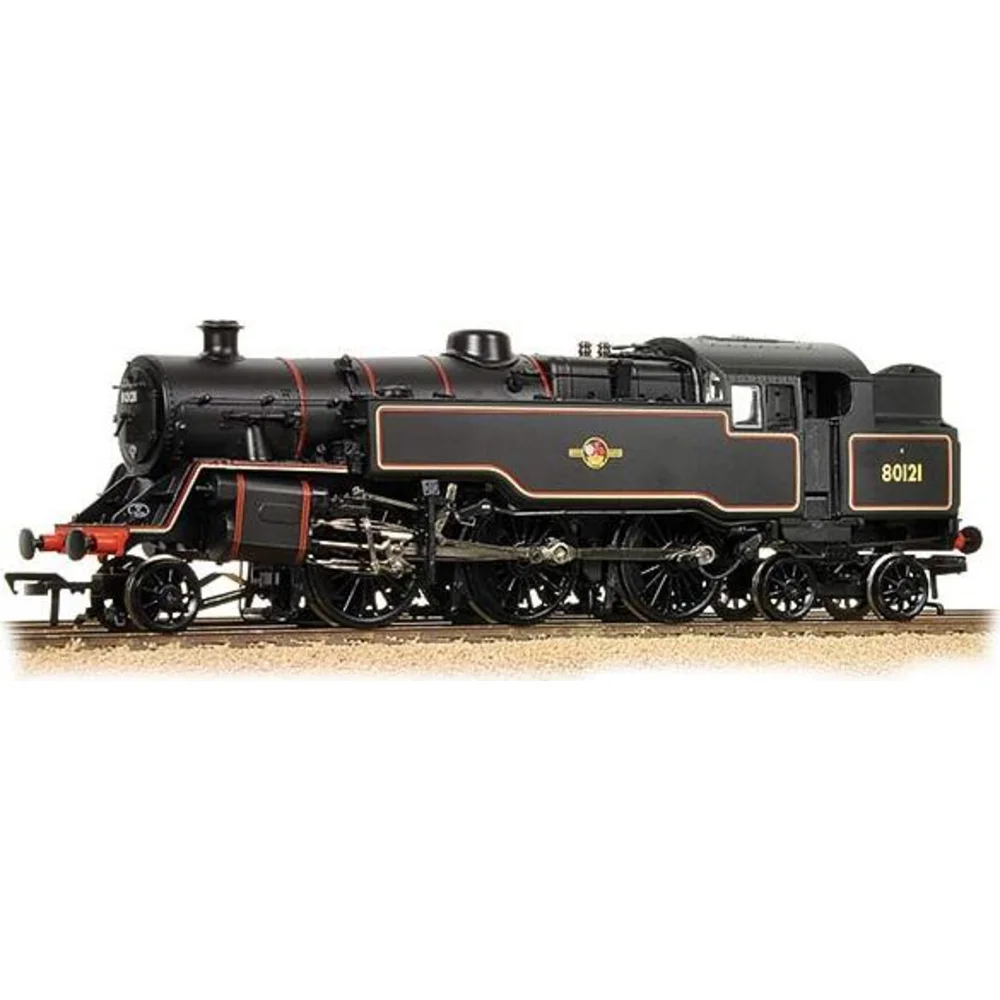Bachmann 32-360
British Railways Standard Class 4 2-6-4T 80121 British Railways Lined Black with Late Crest
Tooling
In 2005, Bachmann Branchline introduced a major upgrade to its OO gauge model of the BR Standard Class 4 2-6-4T tank locomotive. This revision replaced the earlier 2001 tooling and reflected the growing demand for higher fidelity and digital readiness in British outline models. The prototype, designed by R.A. Riddles and built between 1951 and 1956, was a versatile mixed-traffic tank engine widely used on suburban and secondary services. The 2005 tooling brought enhanced detailing, improved mechanical design, and factory provision for DCC, setting a new benchmark for mid-range steam models.
Tooling Features
- Scale: OO gauge (1:76).
- Construction: Plastic body with metal chassis components for strength and weight.
- Detailing: Factory-fitted separate details including handrails, lamp irons, pipework, turned brass safety valves, smokebox door dart, and bufferbeam detail. Sprung buffers and opening smokebox door added realism. Cab interior featured improved glazing and painted detail.
- Couplings: NEM pockets with tension-lock couplers.
Mechanical & Electrical
- Motor & Drive: Smooth-running 3-pole motor mounted in the chassis, driving all coupled axles via a gear train.
- Minimum Radius: Recommended second radius (approx. 438 mm); capable of first radius but not ideal for appearance or performance.
- Lighting: None fitted.
- Weighting: Balanced weight within boiler and chassis for good adhesion.
DCC Capability
The 2005 tooling was DCC Ready, featuring an 8-pin NMRA socket located in the chassis. This made decoder installation straightforward compared to the hard-wiring required on the earlier 2001 version.
Liveries Produced (2005 onwards)
- BR Plain Black (unlined).
- BR Black with Early Emblem (1949–1957).
- BR Black with Late Crest (1957–1968).
- BR Green with Late Crest (1957–1972).
- Weathered and preserved examples introduced in later years.
Reviews & Commentary
The 2005 upgrade was widely praised for its improved accuracy and finish. Reviewers highlighted the fine detail, chemically blackened wheels, and realistic valve gear. The addition of an 8-pin DCC socket was considered a major step forward. Running qualities were generally smooth, though some users noted minor slowing on tight curves and recommended careful lubrication. Enthusiasts appreciated the opening smokebox door and sprung buffers, features that added to the model’s premium feel.
Video reviews and forum discussions from the period commended the model’s robustness and visual appeal, while noting that sound capability was absent—a common limitation before factory-fitted sound became mainstream.
Interesting Facts
- The 2005 tooling formed the basis for subsequent factory-fitted DCC and weathered editions, keeping the model competitive for over a decade.
- Preserved locomotives such as No. 80072 inspired special edition releases in later years.
Class & Prototype
- Class: British Railways Standard Class 4 2-6-4T
- Traction: Steam
- Built: 1951-1957
- Total Built: 155
- Running Number: 80121
Operator & Livery
- Operator: British Railways
- Livery: Lined Black with Late Crest
- Era: 5 - British Railways Late Crest
British Railways transformed Britain's fragmented rail network into a unified national system following nationalisation on 1st January 1948. Created from the "Big Four" companies under the Transport Act 1947, BR operated most of Great Britain's railways until rebranding as British Rail in 1965, managing over 20,000 route miles and inheriting nearly 20,000 locomotives of diverse designs.
The organisation pioneered standardisation through its revolutionary BR Standard locomotive programme (1951-1960), producing 999 advanced steam engines under Robert Riddles' direction. These included the versatile Britannia Pacifics, mighty 9F freight engines, and mixed-traffic classes that incorporated the best features from all predecessor companies. The 1955 Modernisation Plan accelerated diesel and electric traction development, creating fascinating mixed-traction operations.
Notable achievements included establishing unified locomotive classification systems, introducing distinctive corporate liveries, and managing the complex transition from steam to modern traction. BR's six regional structure preserved operational diversity whilst enabling standardisation of practices, signalling, and rolling stock that had eluded private enterprise for over a century.
The BR era represents steam traction's final flowering alongside emerging diesel technology, creating unparalleled locomotive variety. Today, this heritage remains highly popular with railway enthusiasts through extensive preserved fleets, heritage railway operations, and comprehensive model ranges from manufacturers like Hornby, Bachmann, and Dapol, making BR subjects essential for authentic post-war British railway modelling across all scales.
